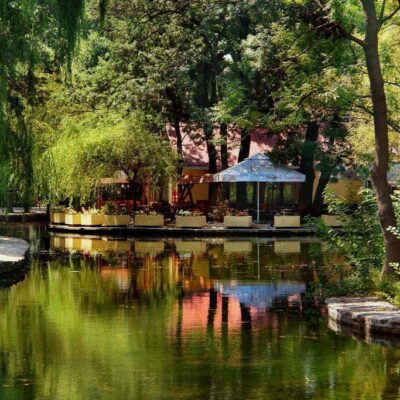The city of Buzău has great tourist potential, which is why we invite you to consider a visit here. The main asset of the city is its historic center, with its various museums, monuments and a number of architecturally impressive buildings.
The specific landscapes of the area are also a good reason to plan a holiday in this land, as there are natural beauties and recreation areas to be found everywhere.
The first documentary attestation of the locality dates from 1431. At that time, Buzău had the status of a merchants’ fair and customs point. In the 16th century, the fair became an episcopal see.
During the seventeenth century, there are a number of battles, invasions and natural disasters that negatively affect the development of the town, bringing it to the brink of destruction. Even so, the city was not left in ruins and the locals fought for its reestablishment. Therefore, the nineteenth century saw the cultural and economic rise of the city, many buildings being erected during this period and whose beauty we can still enjoy today.
During the First World War, the town suffered and its development was endangered, but after this period of hardship, the process was resumed. After the Second World War, the process of industrialization began, and after 1989, capitalism was installed.
Buzău is the municipality of residence of the eponymous county and is placed in the southeastern part of the country, in Muntenia. The city is located in a low area, surrounded by the Eastern Carpathians and the Sub-Carpathians in the northwest, and by the Wallachian Plain with its Sub-Carpathian Hills in the southeast.
The neighboring regions are: to the northwest – Brașov and Covasna, to the northeast – Vrancea, to the east – Brăila, to the west – Prahova and to the south – Ialomița.
Palatul și Parcul Marghiloman – it represents an important historical monument and one of the main attractions of the city. It is a complex of historical monuments consisting of the Albatros Villa and annex buildings, and it is a perfect place for recreation and strolling.
The palace is built in the neoclassical style in the 19th century and was the residence of the boyar Grigore Marghiloman. Today, it hosts various cultural events and exhibitions. The park surrounds the palace and offers an oasis of peace and greenery in the midst of urban hustle and bustle, making it ideal for relaxing walks or moments of rest in nature.

Crâng Park – the locals’ favorite relaxation spot, rich in green spaces. At the heart of the park is an island with a restaurant. With its shady pathways, central lake, and numerous recreational areas, the park is the ideal place for outdoor walks, picnics, or sports activities. You can play outdoor chess, let your children play freely in specially designed spaces, or take a pedal boat ride on the lake.
Additionally, the park hosts various cultural events and exhibitions, attracting both locals and tourists in search of recreation and entertainment.

Buzău County Museum – It is a remarkable cultural destination that showcases the history and rich heritage of the county. Situated in an emblematic building, classified as a historical monument, the museum hosts numerous archaeological, ethnographic, and artistic exhibits that illustrate the evolution and cultural diversity of the region. The construction dates back to 1920, and besides the museum collection, it also houses the “George Ciprian” Theater.
Visitors can explore the permanent collections and temporary exhibitions, uncovering the secrets and historical treasures of Buzău and the surrounding region.

Vergu-Mănăilă House – It is another historical monument building, erected in 1794. It hosts the Collection of Ethnography and Folk Art, with over 3,800 artifacts specific to the area. The permanent exhibition offers an insight into traditional life in Buzău, reconstructing a peasant household from the 19th century. Here, visitors can discover aspects related to divinity, nature, and local tradition, contributing to the preservation and promotion of Buzău’s cultural heritage.

The Communal Palace – Built between 1899 and 1903, it is an architectural symbol of the city, designed in a Neo-Romanian style with Art Nouveau influences. The project is the work of architect Alexandru Săvulescu and was inaugurated in 1903, in the presence of prominent personalities of the time. The Palace was partially destroyed during the bombings of 1944 and set on fire during the same period. Despite its tumultuous history, it remains one of Buzău’s most impressive monuments, representing a valuable testimony to its rich past.
Today, it houses the City Hall.

Buzău does not have an airport, the closest is the “Henri Coanda” Airport in Bucharest, located 110 km away.
There is however an important railway junction in Buzău, so you can use the train to travel to most cities and towns in the country.
If you prefer a faster option, you can choose to travel by bus / minibus. Here you will find all the necessary information for this: bus stations and stops, departure and arrival times, destinations.
If you want to travel from Bucharest to Buzău by car, you can take the DN2 (E85).

If you like music festivals, in Targu Mures you will find one to your taste, regardless of the style of music you prefer. Here you have a list with some of them, but you should know that every weekend there are events for all tastes.
The Seafood, Paella & Sangria Festival – takes place between 5-8 September and is the ideal occasion for seafood lovers to indulge in various seafood dishes. Hundreds of kilograms of crayfish, shrimp, octopus, squid and other such delicacies are cooked during this event. The culinary festival takes place in Dacia Square in Buzău.
What are you waiting for? Come and have a good time, enjoy music, nice people and magical places.